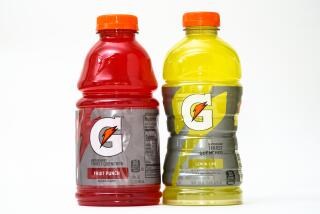Gum industry is finding itself stuck
Amid shifts in the gum industry, a bit of Americana might be going away — the colorful gum balls once sold for a penny from machines at drugstores, arcades and supermarkets.
The main problem with the classic, round gum balls is that although they’re available in many flavors and colors, almost all of them have one thing in common — a heavy dose of sugar. Long the scourge of dentists, this product has come in for a drubbing at a time when child obesity has focused attention on sweets.
“More gum ball operators are finding it harder to make a living,” said Spencer Williams, president of Gumball.com, an Irvine gum, candy and vending machine wholesaler.
The struggles in the gum ball business mirror the challenges facing the entire chewing gum industry. The amount of all gum sold in the U.S. was expected to be static in 2011 compared with the previous year, according to a September report from research group Euromonitor International. Overall revenue was expected to rise slightly.
Many gum ball machines aren’t even being used for gum balls anymore.
Williams said that about 45% of the gum ball machines operated by his clients now dispense small toys. Only about 27% dole out gum balls, with the rest stocked with candy and other items.
Research figures on gum balls are hard to come by, but Richard Ackerberg — whose American Gumball Machine Co. in Marina del Rey sells the machines to vendors — said he has seen the decline firsthand.
Although machine sales are still strong — mostly to entrepreneurs hoping to use them for part-time income — each unit is now pulling in only about half the money it did a decade ago, Ackerberg said.
“The industry has tried many different things — sugar-free gum balls, organic versions — but those have over and over again been unsuccessful,” Ackerberg said. “We’ve tried to elevate the taste, and quite frankly, it hasn’t changed anything. Customers still don’t want it.”
Add the rising price of sugar to those woes.
Unlike more technologically advanced vending machines for which prices can be easily adjusted, old-fashioned gum ball machines usually accept only one kind of coin — once a penny, now typically a quarter. And that makes it tough to implement incremental price hikes.
But gum ball sellers aren’t the only ones in a rut. Chewing gum makers are also trying to boost sales.
“We’re certainly not satisfied with our gum results,” said Irene Rosenfeld, chief executive of Kraft Foods Inc., one of the country’s top gum producers. In a conference call with food industry analysts in August, she blamed the slide on “the decline of pocket money among teens, our biggest consumer segment,” as well as on disappointing sales of some new products.
Kraft — whose brands include Dentyne, Trident and Stride through its Cadbury subsidiary — said its North American gum and candy division suffered a double-digit revenue tumble midway through 2011.
Mars Inc., the top gum manufacturer in the U.S., owns Wrigley and its brands, which include Doublemint and Extra. As a privately held company, it doesn’t publicly disclose much about its business.
Vic Mehren, a senior marketing director for Wrigley, said that keeping gum desirable for consumers is an industrywide challenge.
“Gum is a discretionary purchase, an impulse purchase,” Mehren said. “We need to evolve along with how consumers’ lifestyles are evolving. We need to be bringing new reasons for people to be chewing gum.”
Just about the only growth area in the industry overall is in sugarless offerings, which Euromonitor said “continues to be the saving grace in gum.”
The research company said that sales of sugarless gum products were expected to increase 4% in 2011 to $3.3 billion. That would make it the only gum category to increase its revenue three years in a row.
Gum makers have also pinned some of their hopes for growth on another area — the so-called functional gums that offer benefits other than breath-freshening.
Stride Spark, a brand from Cadbury launched last year, says it contains 25% of the recommended daily intake of vitamin B6 and B12. Jolt, owned by New Jersey company GumRunners, has caffeine to help boost energy. Also getting into the act is the Rockstar drink company, which introduced a caffeine-packed “energy gum” in 2010.
Some functional gums didn’t click. In 2003, Wrigley discontinued its Surpass antacid gum over lack of sales.
Other functional gums have been sued over their claims. Wrigley had to pay up to $7 million after losing a class-action lawsuit over its assertion that its Eclipse gum was scientifically proven to kill foul-breath germs. Cadbury was sued by a customer who said that Trident’s Xtra Care gum’s promise to strengthen and rebuild teeth didn’t pan out.
Euromonitor said it believes functional gum is “faltering” because of consumer skepticism. The research group says revenue in the sector probably declined for the third straight year in 2011, down 6% to $293 million.
Other attempts are being made to boost sales.
To nab socially conscious and health-oriented consumers, gums from British company Peppersmith and Verve Inc. of Rhode Island boast of having no artificial flavors or colors and say they use tree sap chicle as a natural sweetener. And Rev7 gum — available in peppermint, spearmint and cinnamon and made by the British company Revolymer — says it’s biodegradable, dissolving into easily cleaned powder within months.
Time will tell whether the new gums catch on. But for now, there’s at least one group that hopes they don’t succeed — janitors.
“Gum is always a pain to get up,” said Marc de Mauregne, president of MNZ Janitorial Services Inc. in Los Angeles.
And gum stuck to pavement, floors and shoes has become more prevalent, he said, because in a tough economy building owners don’t want to pay to get it removed from sidewalks and other spots.
“If you look down these days, you’ll see it,” De Mauregne said. “It’s nasty.”
More to Read
Inside the business of entertainment
The Wide Shot brings you news, analysis and insights on everything from streaming wars to production — and what it all means for the future.
You may occasionally receive promotional content from the Los Angeles Times.










